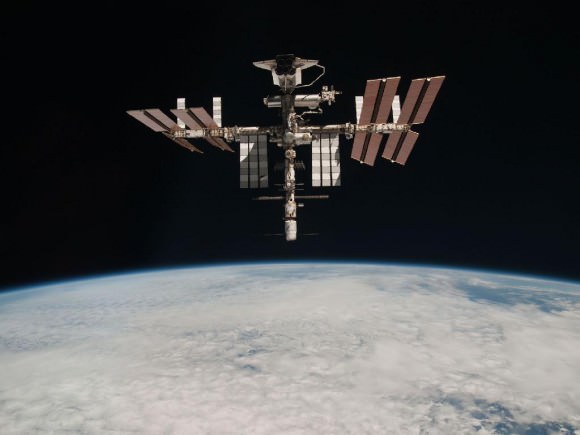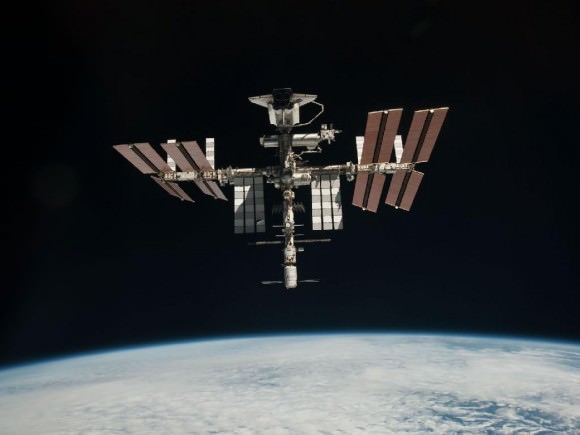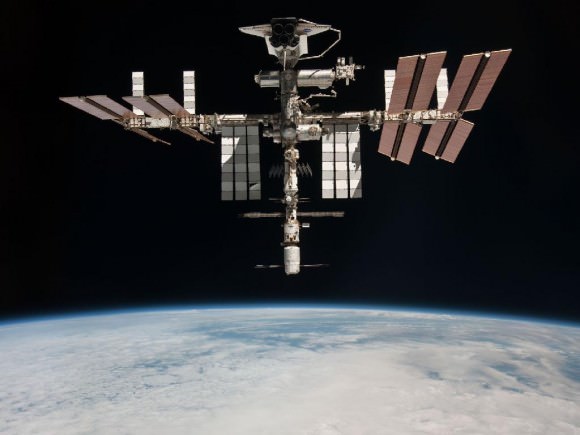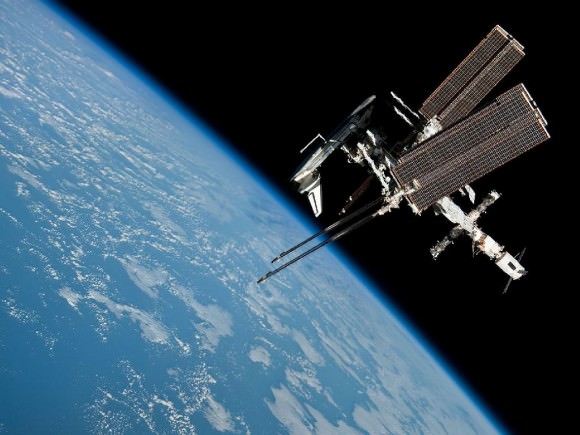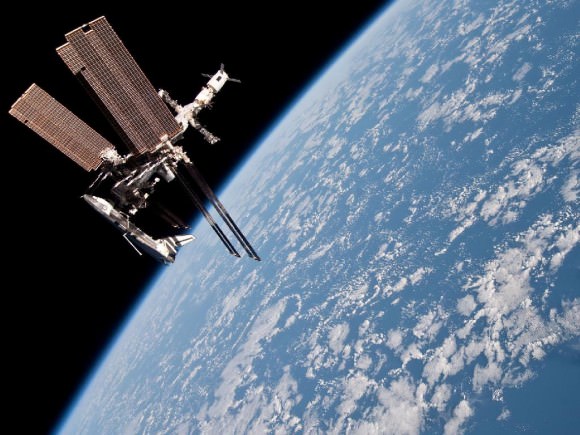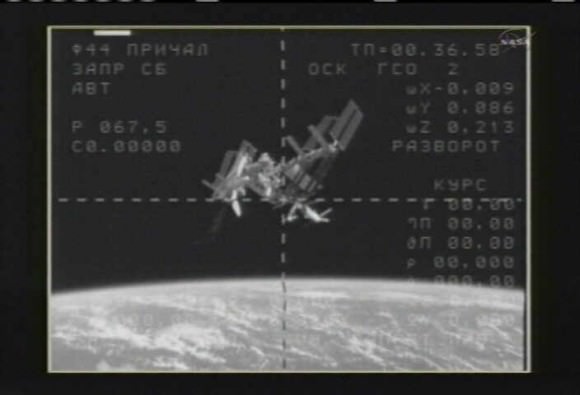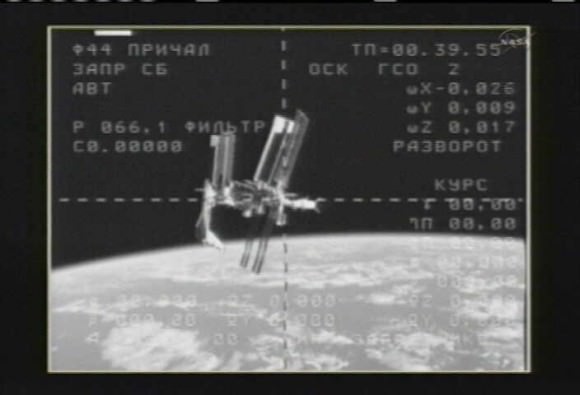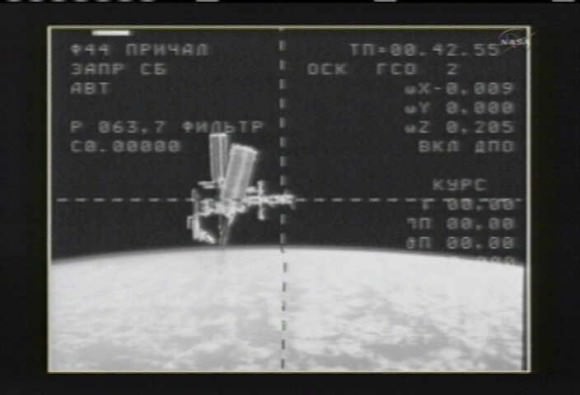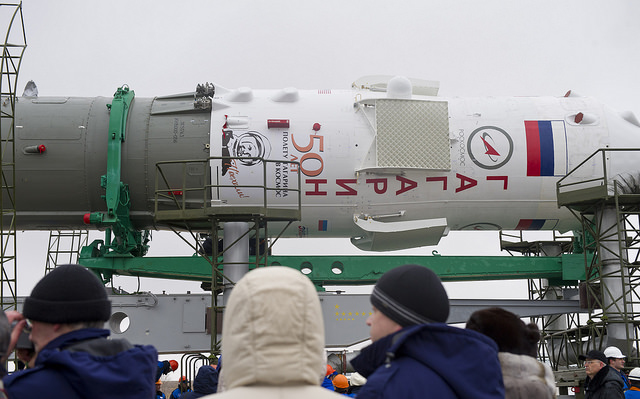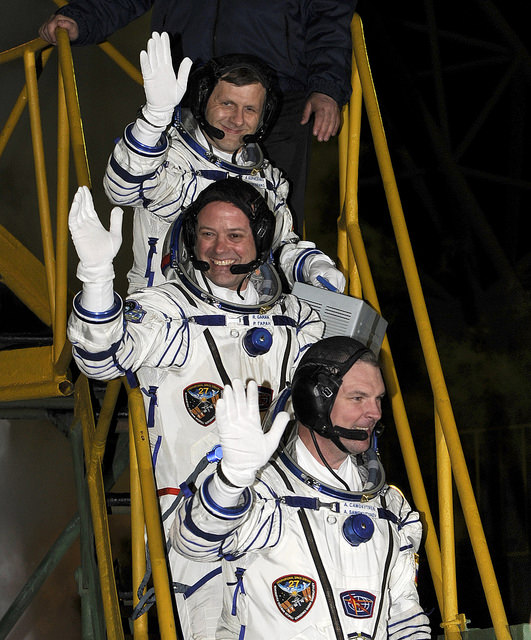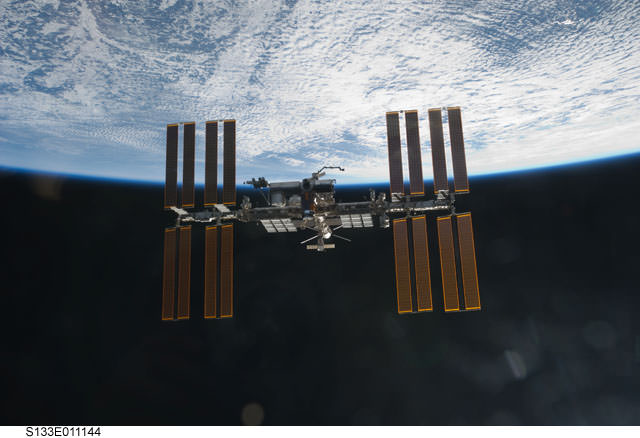In an epitome of internationalism, an international crew of three new ISS crew members — NASA astronaut Mike Fossum, Russian cosmonaut Sergei Volkov and Japan Aerospace Exploration Agency astronaut Satoshi Furukawa — launched from the Baikonur Cosmodrome in Kazakhstan aboard the Soyuz TMA-02M spacecraft at 4:12 p.m. EDT (2:12 a.m. Wednesday, Baikonur time) beginning their two-day journey to the space station. They are expected to dock at the ISS 4:22 p.m. Thursday, June 9.
Continue reading “Soyuz Launches With New “International” Space Station Crew”
NASA Releases Spectacular Portrait Photos of Endeavour Docked at the ISS from Soyuz and Paolo Nespoli
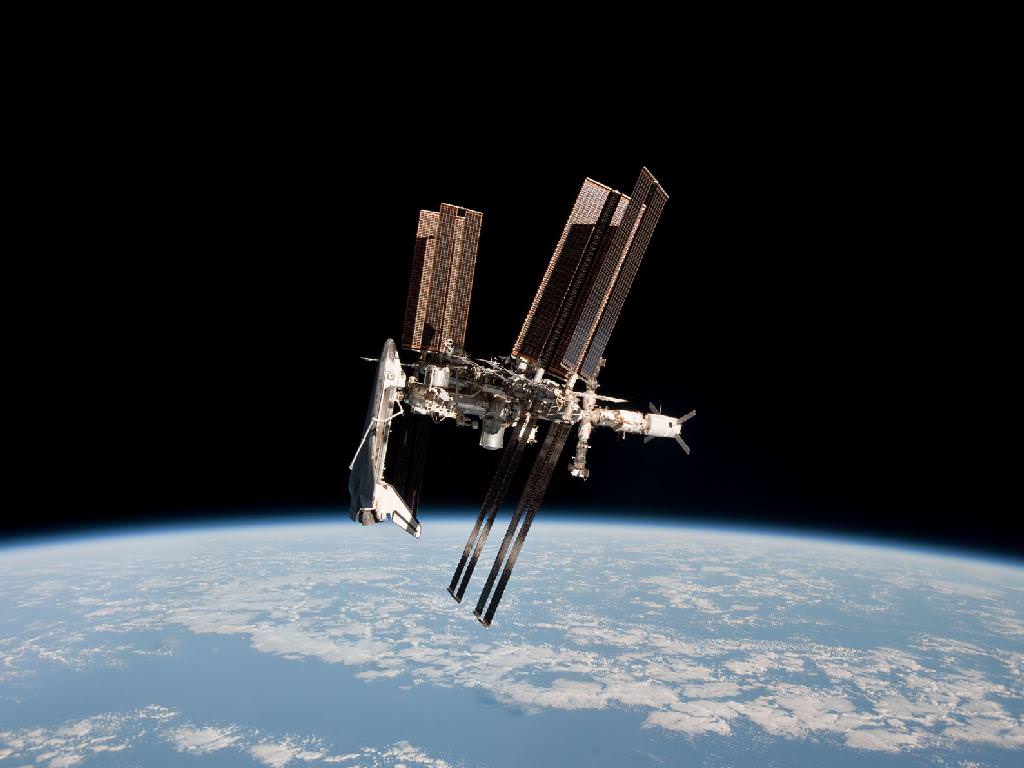
[/caption]
NASA has at last today (June 7) released the spectacular portrait photos of Endeavour docked at the International Space Station (ISS). These are are the first ever images taken of a space shuttle while still attached to the orbiting lab complex from the perspective of a crewed Russian Soyuz spacecraft.
The breathtaking digital images were captured by Italian astronaut Paolo Nespoli on May 23 through a window inside the Soyuz TMA-20 vehicle as he and two crewmates were departing the ISS for their return trip to Earth.
Story Update: Check out the expanded photo gallery of more awesome images released by NASA later today
The ISS/Shuttle stack and Soyuz were flying at an altitude of 220 miles as the Soyuz undocked with Nespoli, Russian cosmonaut Dmitry Kondratyev and NASA astronaut Cady Coleman. After they were about 600 feet away, Mission Control Moscow commanded the ISS to rotate 130 degrees to give a full view of the entire complex from the side.
Nespoli then had about 30 minutes to capture high resolution digital photos and videos of Space Shuttle Endeavour docked to the orbiting lab for the very last time in the midst of her 16 day long final mission; STS-134.
The Soyuz trio landed safely in Kazakhstan later that day.
The imagery was to have been made public a day or two after the landing. But Nespoli accidentally left the SD data cards behind in the Soyuz vehicle, causing them to processed more slowly as part of routine post flight analysis.
Space Shuttle Endeavour and ISS Portrait Photo Gallery
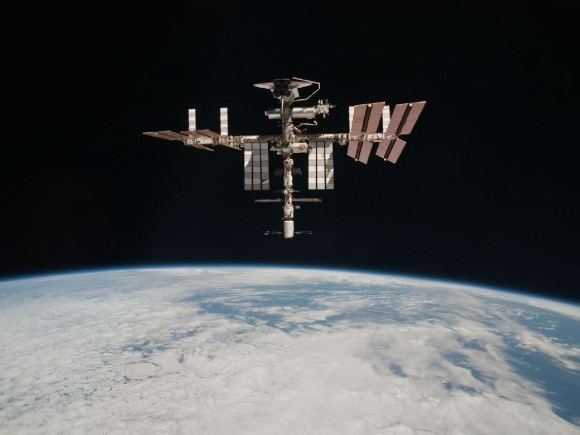
This image of the International Space Station and the docked Space Shuttle Endeavour, flying at an altitude of 220 miles was taken by Expedition 27 crew member Paolo Nespoli from the Soyuz TMA-20 following its undocking on May 23, 2011 (USA time). It is the first-ever image of a space shuttle docked to the International Space Station. Endeavour at top. European ATV cargo carrier at bottom. Credit: NASA/Paolo Nespoli
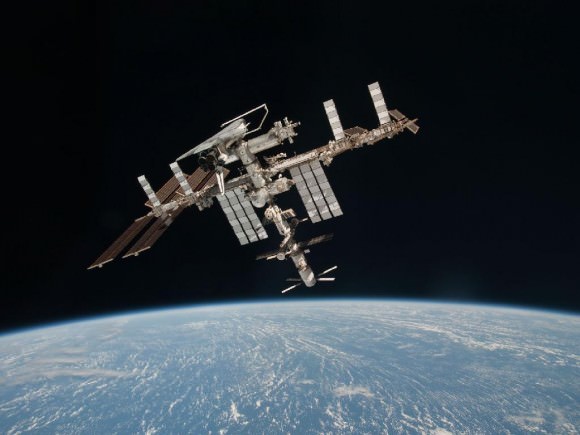
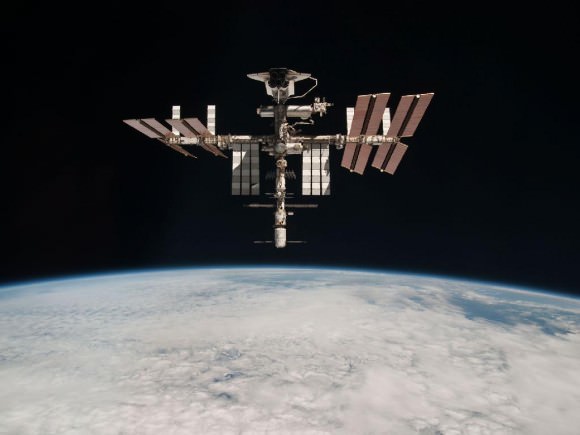
NASA’s expanding photo gallery here:
Read my earlier features about the portrait photos of Endeavour and the ISS here:
Spectacular Soyuz Photo Gallery shows Unprecedented View Of Shuttle Docked at Station
Ultimate ISS + Shuttle + Earth Photo Op Coming on May 23 from Soyuz and Paolo Nespoli
Read my features about the final mission of Endeavour, STS 134, starting here
STS-134 Shuttle Commander Mark Kelly appears at U2360° Concert in Seattle: Music Video
Era of Space Shuttle Endeavour Ends with June 1 landing at the Kennedy Space Center
Soyuz Crew Lands Safely
[/caption]
The Expedition 27 crew of Commander Dmitry Kondratyev and Flight Engineers Paolo Nespoli and Cady Coleman landed upright in a remote area southeast of the town of Dzhezkazgan, Kazakhstan, on Tuesday, May 24, 2011, after more than five months onboard the International Space Station. After undocking fromt he station, Nespoli took the first still images and video of a space shuttle docked to the station. In order to get the best view for the photo-op, the ISS had to rotate 130 degrees.
See a (shaky) video of the landing, below.
Russian recovery teams helped the crew exit the Soyuz and adjust to gravity. Kondratyev will return to the Gagarin Cosmonaut Training Center in Star City, outside of Moscow, while NASA’s Coleman and Nespoli of the European Space Agency will fly directly to Houston.
They launched on a Soyuz back on Dec. 15, 2010, and spent 159 days in space. They worked on more than 150 microgravity experiments in human research; biology and biotechnology; physical and materials sciences; technology development; and Earth and space sciences.
Spectacular Soyuz Photo Gallery shows Unprecedented View Of Shuttle Docked at Station
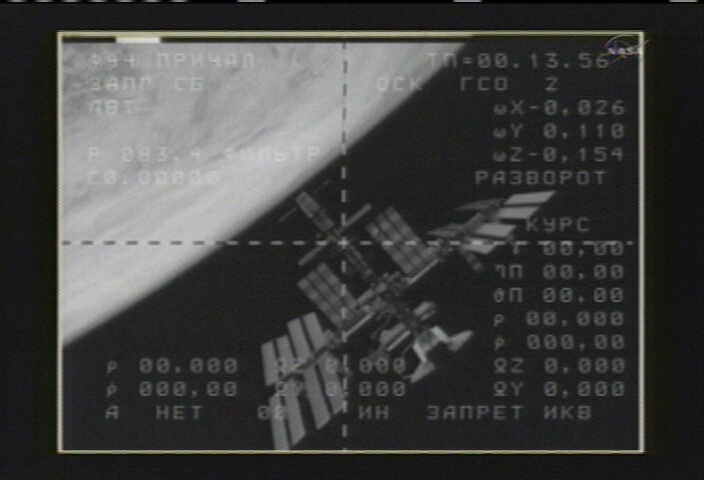
[/caption]
KENNEDY SPACE CENTER – Unprecedented and spectacular photos showing a US Space Shuttle Orbiter docked to the International Space Station (ISS) were snapped just hours ago and transmitted live back to ground stations and viewers on Earth as a Soyuz capsule with three space flyers departed from the station at 5:35 p.m EDT on the first leg of their journey back to Earth. And the best is yet to come.
Check out the photo galley of historic black and white gems captured from an engineering docking camera attached to the nose of the Russian Soyuz capsule that undocked this evening (May 23) from the ISS. These historic photos are the first ever showing a shuttle joined to the massive orbiting complex.
As the Soyuz was backing away from the Russian-built Rassvet module, Italian Astronaut Paolo Nespoli was busily snapping first of its kind high resolution color photos and videos of Space Shuttle Endeavour attached to the ISS.
The entire complex was simultaneously rotated 130 degrees to provide the best possible view of the whole shuttle-station stack. The combined stack weighs more than a million pounds
Nespoli had about 30 minutes to collect high resolution digital imagery from a viewing port inside the habitation module of the Soyuz spacecraft that burns up on reentry. He then removed the cards from the cameras and floated back into the Soyuz descent module.
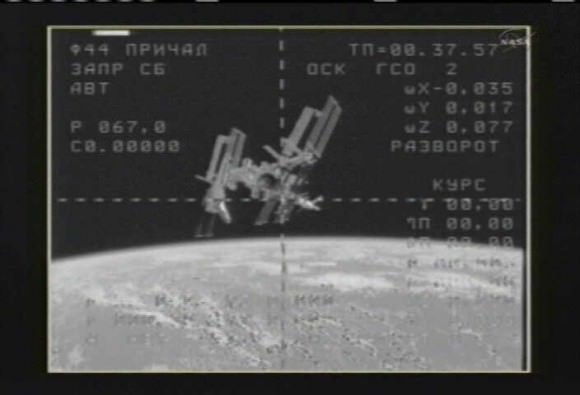
NASA and Russia expect to release high resolution digital imagery on Tuesday or Wednesday.
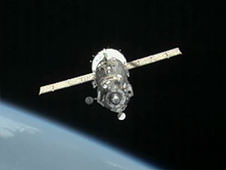
The three person Expedition 27 crew comprising of Commander Dmitry Kondratyev and Flight Engineers Cady Coleman and Paolo Nespoli landed safely in their Soyuz spacecraft on the Kazakhstan steppe Monday at 10:27 p.m. (8:27 a.m. on May 24 local time) at a site southeast of the town of Dzhezkazgan.
Shuttle Endeavour is in the middle of the 16 day STS-134 mission and delivered the $2 Billion Alpha Magnetic Spectrometer to the ISS. The AMS is a particle physics detector searching for the invisible Universe and seeks to elucidate its birth and evolution. The all veteran crew of 6 is led by Shuttle Commander Mark Kelly.
Read my related stories about the STS-134 mission here:
Ultimate ISS + Shuttle + Earth Photo Op Coming on May 23 from Soyuz and Paolo Nespoli
Endeavour Blasts Off on Her 25th and Final Mission
Endeavour Unveiled for Historic Final Blastoff
Looking to the Heavens with Endeavour; Launch Pad Photo Special
Endeavour Astronauts Arrive at Cape for May 16 Launch
NASA Sets May 16 for Last Launch of Endeavour; Atlantis Slips to July
Endeavour’s Final Launch further delayed another Week or more
On the Cusp of Endeavour’s Final Flight
Brush Fires Erupt at Kennedy Space Center during Endeavour’s Last Countdown
Commander Mark Kelly and STS-134 Crew Arrive at Kennedy for Endeavour’s Final Flight
President Obama to Attend Endeavour’s Last Launch on April 29
Shuttle Endeavour Photo Special: On Top of Pad 39A for Final Flight
Endeavour Mated to Rockets for Last Flight Photo Album
Endeavour Rolls to Vehicle Assembly Building for Final Flight
Ultimate ISS + Shuttle + Earth Photo Op Coming on May 23 from Soyuz and Paolo Nespoli
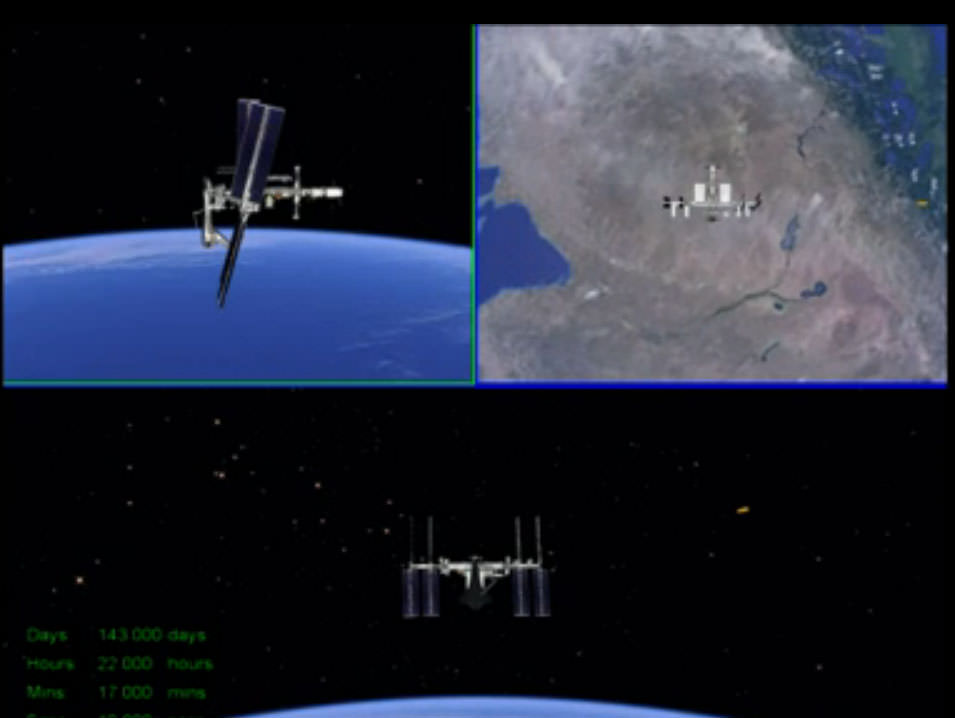
KENNEDY SPACE CENTER: Get ready for the ultimate photo op in space – set for the International Space Station joined to Space Shuttle Endeavour and topped off by Planet Earth as the backdrop.
And it’s coming up momentarily because of an unexpected and “unique opportunity” that’s also taking place at nearly the last possible moment in the life of the soon to be retired Space Shuttle program.
On Monday, May 23, Italian Astronaut Paolo Nespoli will snap the first ever photos and video of a US Space Shuttle orbiter while it is simultaneously still docked to the International Space Station, NASA officials just announced on Friday, May 19.
Video Caption: This computer generated animation depicts the view the Soyuz crew will see as they depart from the International Space Station (upper left) on May 23, 2011 at 5:32 p.m. EDT. Italian Astronaut Paolo Nespoli will capture an incredible and first ever imagery of the stacked station/shuttle complex with a space shuttle orbiter; the Endeavour. Bottom view shows side view of the Soyuz departing the ISS. Credit: NASA
Nespoli will capture the dramatic and historic imagery – in a newly devised plan – while he is departing the “Shuttle- Station stack” aboard a Russian Soyuz spacecraft and heading for a landing back on Earth with two crewmates barely 4 hours later in Kazakhstan.
“We have a unique opportunity. We are calling this Soyuz undock with imagery,” said Kenneth Todd, chair of NASA’s space station mission management team. “We are not calling this a Soyuz flyaround or flyabout.”
“This is going to be a great opportunity for the spaceflight community.”
After months of high level international negotiations since the STS-133 mission, NASA and Russian space officials from the space shuttle and space station teams have finally agreed on a arrangement for utilizing a crewed Soyuz vehicle to record the first ever photos showing a shuttle while still docked to the massive orbiting outpost in the same field of view.
The chance to do the shuttle- station photo documentation in this way only became possible when the launch of Space Shuttle Endeavour was scrubbed on April 29 and the resulting delayed launch of the STS-134 mission on May 16 fortuitously afforded an overlapping time period that coincided with the Soyuz TMA-20 crew departure.
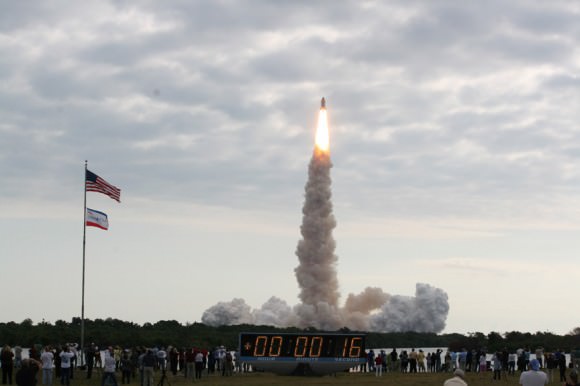
View from the countdown clock at NASA’s Kennedy Space Center. Endeavour has delivered the $2 Billion Alpha Magnetic Spectrometer to the International Space Station. The AMS will search for dark matter, dark energy and antimatter to determine the origin and evolution of the Universe. Credit: Ken Kremer
The photo opportunity will take place under what’s called a dual docked operations scenario whereby the Soyuz is undocked while a shuttle is still attached to the ISS.
“With 100 percent consensus, we approved this change to the baseline mission to go add this photo documentation task as part of the Soyuz TMA-20 undock,” Todd explained.
In order to accommodate the extra time required to accomplish the photo shoot, the Soyuz TMA-20 capsule will undock from the ISS one orbit earlier than originally scheduled, about 90 minutes, at 5:32 p.m. EDT.

on 29 June 1995.
Check out this perspective of what a space shuttle looks like when docked to an Earth orbiting space station. Atlantis is docked to the Mir Space Station on 29 June 1995 during the STS-71 mission. The shuttle has never before been photographed while attached to the Internalional Space Station. The photos of the Shuttle Endeavou and ISS Space Station stack are expected on May 23, 2010. Credit: Roscosmos
Nespoli is departing with ISS Expedition 27 commander and Russian cosmonaut Dimitry Kondratyev and NASA astronaut Catherine “Cady” Coleman. They will be completing a nearly six month stint in space aboard the ISS.”
“After the Soyuz undocks, they will back out to about 200 meters,” explained Courtney McMillan, STS-134 Station Team 4 Flight Director. “You will see they are a little bit above the velocity vector, above the station, and that is to keep the sun out of the pilot’s eyes.”
“After they get to the station keeping point, ISS will begin to maneuver, turning 130 degrees at 0.2 degrees per second.” The attitude was designed to provide the best perspective of the ISS and Endeavour.
“It will take 15 minutes to bring the whole stack around to get a side view and a really good view of Endeavour. This is an unusual attitude for the station to fly during a mated mission and people have done a lot of work to make sure this is a good thing to be doing. They have scrutinized the issue and are very comfortable with the plan.”
The station move will be done using thrusters on the Russian Segment service module – named Zvezda – and the thrusters on the docked Progress 42P vehicle, an unmanned Russian cargo ship. See diagram below.
Nespoli will have to float into the Soyuz vehicles forward habitation module – from his seat in the central descent module – and then snap the photo and video imagery through the modules windows. He will have a direct line of sight to the stack.
Paolo will have roughly 30 minutes time to collect all the imagery of the combined space complex during the photo survey, starting at about 5:50 p.m. EDT.
Then he will float back out of the habitation module, carefully seal the hatches in between and take his seat in the descent module.
The habitation module burns up in Earth orbit after the modules separate in preparation for the Soyuz’s deorbit and scorching reentry into Earth’s atmosphere.
Since the Soyuz will be pitched up during the undocking sequence, breathtaking views of Earth in the background of the “Shuttle-
Station stack” are expected.
The goal is to get good archival imagery of the space station stack with the shuttle attached. In addition to the gee whiz factor there are good reasons from an engineering perspective to record this imagery to assess the condition of the orbiting complex, NASA managers said.
“Future generations will look back on their history and look back at what we accomplished between these two very, very large programs – the shuttle and the space station – and realize it was amazing what we accomplished with the technology available at the time.”
“These pictures will be in textbooks to show what we did”, said Todd.
Exactly when the digital photos and video will be available for all to see is still to be determined. NASA and Russian space officials are discussing the details of when and how to distribute the imagery. The Soyuz is not equipped to transmit the imagery in real time.
“We hope to start seeing the photos and videos within a day of landing”, said Todd.
Paolo has snapped many gorgeous shots during his stay in space, including these of an Ariane V launching the European ATV cargo craft from French Guiana.
Go Paolo !
Read my story about the Final Shuttle mission, STS-135, here:
Atlantis Rolls to Vehicle Assembly Building with Final Space Shuttle Crew for July 8 Blastoff
Read my related stories about the STS-134 mission here:
Endeavour Blasts Off on Her 25th and Final Mission
Endeavour Unveiled for Historic Final Blastoff
Looking to the Heavens with Endeavour; Launch Pad Photo Special
Endeavour Astronauts Arrive at Cape for May 16 Launch
NASA Sets May 16 for Last Launch of Endeavour; Atlantis Slips to July
Endeavour’s Final Launch further delayed another Week or more
On the Cusp of Endeavour’s Final Flight
Brush Fires Erupt at Kennedy Space Center during Endeavour’s Last Countdown
Commander Mark Kelly and STS-134 Crew Arrive at Kennedy for Endeavour’s Final Flight
President Obama to Attend Endeavour’s Last Launch on April 29
Shuttle Endeavour Photo Special: On Top of Pad 39A for Final Flight
Endeavour Mated to Rockets for Last Flight Photo Album
Endeavour Rolls to Vehicle Assembly Building for Final Flight
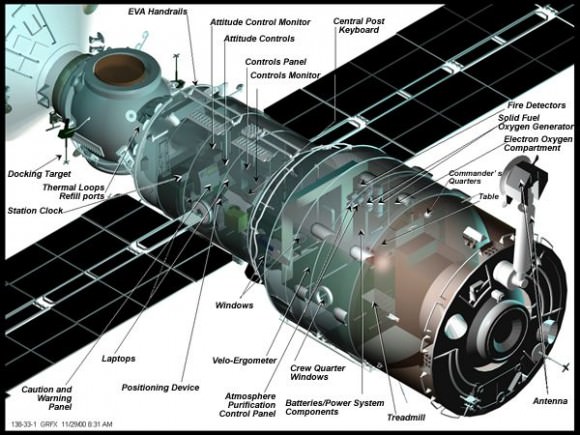
‘Gagarin’ Launches to Space Station
A Russian Soyuz spacecraft launching from the very same launch pad used by Yuri Gagarin when he became the first human in space 50 years ago blasted off from the Baikonur Cosmodrome in Kazakhstan, just a week shy of the April 12th anniversary. The launch took place on time on April 5, 2011 4:18:20 a.m local time (6:18:20 p.m. EDT on April 4), sending two cosmonauts and one astronaut to the International Space Station: Soyuz commander Alexander Samokutyaev, flight engineer Andrey Borisenko and NASA astronaut Ron Garan. The rocket bore the image (see below) and name of Gagarin to celebrate his historic flight.
[/caption]
The crew should reach the ISS on Wednesday.
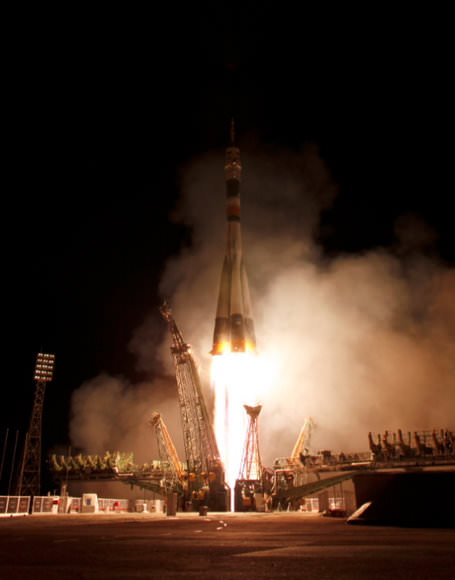
Expedition 27 crew members from top, Russian Flight Engineer Andrey Borisenko, NASA Flight Engineer Ron Garan, and Soyuz Commander Alexander Samokutyaev wave farewell from the bottom of the Soyuz rocket prior to their launch to the International Space Station from the Baikonur Cosmodrome in Baikonur, Kazakhstan, on Tuesday, April 5, 2011. Photo Credit (NASA/Carla Cioffi)
Shuttle Launch Delayed; Soyuz “Gagarin” Launch Set for Today
[/caption]
Just a bit of a traffic jam at the International Space Station has prompted a 10-day delay of the targeted launch for space shuttle Endeavour’s 25th and final mission, STS-134. Originally scheduled for April 19, the shuttle launch is now scheduled for 3:47 p.m. EDT on Friday, April 29. The delay removes a scheduling conflict with a Russian Progress supply vehicle scheduled to launch April 27 and arrive at the station April 29. Current restrictions do not allow a Progress to dock to the station while a shuttle is there.
Meanwhile, A Russian Soyuz spacecraft emblazoned with Yuri Gagarin’s face and name is scheduled to liftoff today (Monday, April 4, 2011) at 6:18:20 p.m. EDT (22:19 GMT) from the Baikonur Cosmodrome in Kazakhstan, bringing two cosmonauts and one astronaut to the ISS to round out the current Expedition 27 crew, returning the crew size to 6. On board will be Soyuz commander Alexander Samokutyaev, flight engineer Andrey Borisenko and NASA astronaut Ron Garan.
The Soyuz will launch from the same launch pad used by Yuri Gagarin when he became the first human in space 50 years ago on April 12, 1961. The Russian Space Agency is dedicating this launch of the Soyuz TMA-21 spacecraft to the anniversary. You can watch the launch on NASA TV.
NASA managers will hold a Flight Readiness Review on Tuesday, April 19 to make sure everything is go for the April 29 launch date for STS-134. The primary goals of Endeavour’s mission are to deliver critical supplies and equipment to the International Space Station, along with a $2 billion Alpha Magnetic Spectrometer, a particle physics experiment. Four spacewalks also are planned to carry out needed maintenance on the orbiting lab complex.
The shuttle launch is already generating a lot of interest – not only because it is Endeavour’s final flight, but also because Commander Mark Kelly’s wife, Congresswoman Gabriel Giffords, is hoping to be present at Kennedy Space Center for the liftoff. She was shot in the head in January of this year, but has recovered sufficiently to consider attending her husband’s final shuttle launch.
One other item of note: NASASpaceflight.com is reporting that a Soyuz flyaround is being considered again while the space shuttle is docked at the ISS. NASA had requested such a flyaround during the previous shuttle mission, STS-133, to be able to take images—both engineering and documentary – of the ISS with spacecraft from each of the partnering space agencies present. Japan’s HTV-2 has now departed, so if the flyaround is approved to take place during the STS-134 mission, that spacecraft would, of course, be missing from the family photo.
Soyuz Lands Safely; Next Crew Launch Delayed
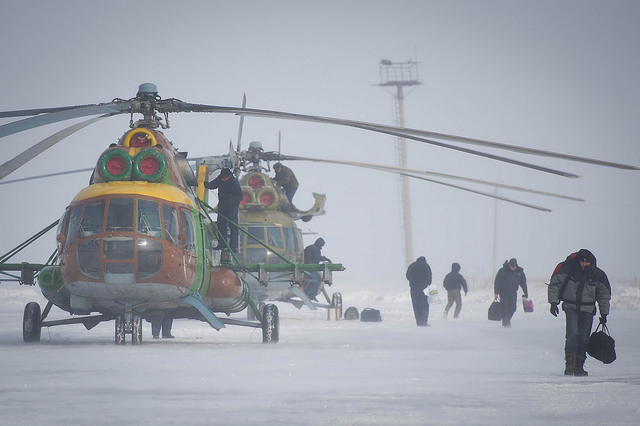
[/caption]
Three members of the Expedition 26 crew landed safely in their Soyuz spacecraft early Wednesday, but their replacements might not launch until mid-April, a delay of a couple of weeks. Commander Scott Kelly and Russian Flight Engineers Alexander Kaleri and Oleg Skripochka landed with no problems in the cold and snow of Kazakhstan, concluding their five-month stay aboard the International Space Station. But meanwhile, the Russian Soyuz TMA-21 is experiencing a problem with the communications system, and the new crew was scheduled to launch on March 29. But the launch may be delayed until after the April 12th 50th anniversary of Yuri Gagarin’s first space flight.
Roskosmos director Anatoly Perminov said technicians were working on a faulty transistor, and if the launch doesn’t take place by about April 9, they would likely be postponed until after the anniversary celebration of the first human to orbit Earth.
The delay could increase concerns about relying solely on Russia for rides to the ISS.
The new crew half of the Expedition 27 crew consists of NASA astronaut Ron Garan and Russian cosmonauts Andrei Borisenko and Alexander Samokutayev. Remaining on board the ISS are Dmitry Kondratyev, now commander and Flight Engineers Catherine Coleman (NASA) and Paolo Nespoli (ESA).
The Expedition 26 trio undocked from the ISS at 12:27 a.m. EDT from the station’s Poisk module, and landed at 3:54 a.m. (1:54 p.m. local time) at a site northeast of the town of Arkalyk.
Working in frigid temperatures, Russian recovery teams were on hand to help the crew exit the Soyuz and adjust to gravity. Kaleri and Skripochka will return to the Gagarin Cosmonaut Training Center in Star City, outside of Moscow, while Kelly will fly directly home to Houston.
The three returning crewmembers have been in space since Oct. 8, 2010 when they launched aboard the Soyuz TMA-01M spacecraft from the Baikonur Cosmodrome in Kazakhstan, spending 159 days in space.
During their mission, the Expedition 25 and 26 crew members worked on more than 150 microgravity experiments in human research; biology and biotechnology; physical and materials sciences; technology development; and Earth and space sciences.
No-go for ‘Fly About’ Photo-Op at Space Station
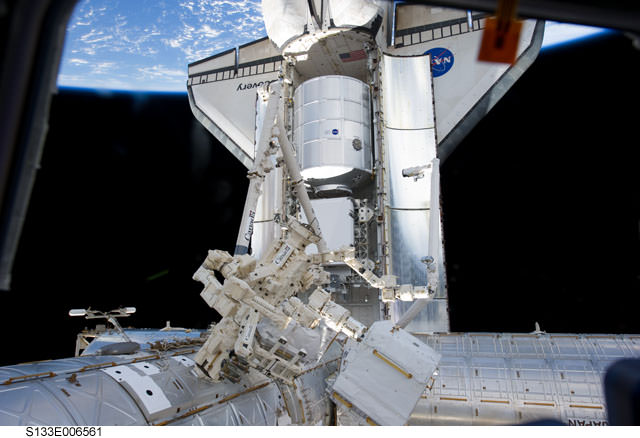
[/caption]
The international partners have decided against an historic ‘fly-about’ of the International Space Station, which would have provided one-of-a-kind images of the nearly completed ISS with space shuttle Discovery and an assortment of vehicles from the different participating space agencies docked to the station.
“This morning, our Russian colleagues, after doing their own independent review processes … have determined that they are not in position to recommend doing the fly about, because this particular vehicle is what they consider a new vehicle, the Series 700 vehicle, which is in its maiden flight,” said Kenneth Todd, a manager for Mission Integration and Operations at NASA, speaking at a mission briefing this morning.
The Russians felt they didn’t have the time or opportunity to fully understand, review and work through all the risks of the request of flying the Soyuz around the ISS, an idea which was presented only recently, and after the new Soyuz had already launched to orbit.
“From a MMT perspective, we knew it was critical for all partners to go through their processes,” Todd said. “It wasn’t necessarily what we were hoping to get back, but at the same point I applaud the Russians for doing the right thing, for not disregarding their own processes and making sure they do their own due diligence the way they should. I accepted the recommendation.”
Mission Control in Houston radioed up to ISS commander Scott Kelly and STS-133 Commander Steve Lindsey that the possible Soyuz fly about was a no-go, even though mission managers had already approved an extra day extension of the shuttle mission.
“We’ll now use that extra day for transfer work between the PMM (Permanent Multipurpose Module) and the ISS, to leave the station and crew in the best possible shape when Discovery undocks.” said Capcom Stan Love. “The fly about will not happen during this flight.”
The fly-about –- only proposed about two weeks ago — would have had cosmonauts Alexander Kaleri and Oleg Skripochka along with Kelly to undock from the Russian Poisk module in the Soyuz TMA-01M spacecraft, back away from the ISS so they could show the ISS in its nearly completed configuration, with the shuttle attached, along with the Russian Progress and Soyuz, the European ATV and the Japanese HTV-1.
Todd said the images would not only be historic from an aesthetic perspective, but also provide valuable engineering views and data.
“There are multiple reasons this was going to be a good thing, to do this photo documentation,” he said. “Everytime we do one of these things we learn a lot, and we get a lot of good data about our ability to do this type of function, not just on our side but on the Russian side. I don’t see our review of this as wasted time or effort, and if we ever need to do this in the future, we will have to assess that at the time.”
Todd added that they should be able to get most of the images and data they were hoping for when the shuttle undocks and departs from the ISS next week – save for the historic aspect of having a shuttle docked to the station, along with all the other visiting vehicles.
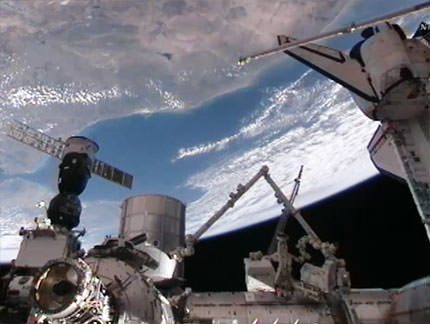
Earlier today, the crews of STS-133 and the space station successfully installed the Leonardo Permanent Multipurpose Module, essentially storage space (a “float-in” closet – which has also been referred to as a potential Man-cave) which includes supplies. Also tucked inside is Robonaut-2, the first human-like robot to serve on board the space station.
Discovery’s landing is currently set for 11:36 am EST on Tuesday, March 8, 2011.
NASA Weighs Risks of Unique Photo-Op at Space Station
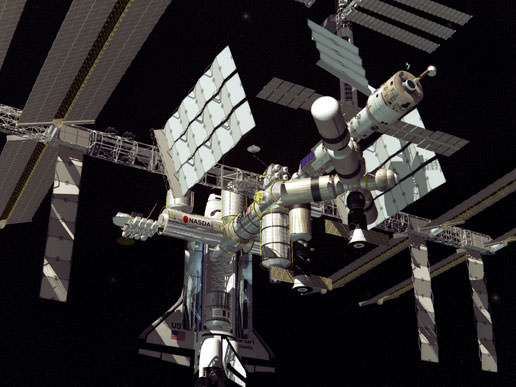
[/caption]
If all goes well and space shuttle Discovery arrives at the International Space Station the end of February, there will be a distinctive configuration: all the international partners will have a vehicle docked to the completed ISS. With the shuttle program about to retire, this configuration will be unique enough – this is the only time it will happen during the shuttle program — that NASA is considering putting three cosmonauts/astronauts in one of the Soyuz capsules that are docked to the station, have them undock and fly around to take pictures of the entire complex.
The Soyuz could photograph the station, showing the ISS in its final, completed configuration, with the shuttle attached, along with the Russian Progress and Soyuz, the European ATV and the Japanese HTV-1.
NASA managers, engineers and contractors are meeting today, Feb. 18 in a Flight Readiness Review to discuss the photo op. Of course, the Russian space agency would have to go along with the idea, as the task would not be insignificant.
Anytime a spacecraft undocks, there is the possibility of a problem or malfunction, and with people involved, the problems multiply fairly quickly. If for some reason the crew could not re-dock, they would have to deorbit and return to Earth, and the ISS crew would all of a sudden be reduced from six to three. Of course, the shuttle crew would be there, but their stay would be limited.
If the plans gets the OK, the crew doing the photo-op mission would ber Alexander Kaleri, Oleg Skripochka and Expedition 26 commander Scott Kelly.

But you have to admit, the pictures and videos would be spectacular, and as things stand now, this would be the one and only chance to get a picture like this, a sort of family photo of the station and all the vehicles that support it.
The feat is not without precedence, however. The Russians took a similar photo on July 4, 1995, when the shuttle Atlantis was docked to the Mir space station, the first time a shuttle visited the Russian space station. Just before Atlantis undocked to return home, cosmonauts Anatoly Solovyev and Nikolai Budarin undocked in a Soyuz spacecraft and photographed the shuttle’s departure from a distance of about 300 feet.
There was a computer problem during the maneuver, however, and the cosmonauts had to dock manually and everything turned out just fine. And the picture was great, too.
The NASA Twitter feed reporting from today’s FRR meeting said the decision to do the photo op will probably not be made until during the STS-133 mission. NASA management is also deciding today when the Discovery mission will actually launch – right now it is scheduled for February 24, 2011 but they are weighing waiting until February 25, as the ATV Johnnes Kepler will arrive at the ISS on the 24th about 6 hours before the shuttle is scheduled to launch. If there were any problems with the ATV, the shuttle might have to stand down.

